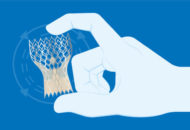Transcatheter aortic valve intervention (TAVI) has been shown beneficial over the years. However, a significant subgroup of patients with small aortic annulus, which make approximately one third of cases and have a higher incidence in women, face additional challenge, such as higher incidence of mismatch, reduced exercise capacity and shorter durability. Self-expanding and balloon expandable…
ACC 2024 | SMART Trial: Self-Expanding or Balloon-Expandable TAVR in Patients with Small Aortic Annulus
Patients with severe aortic stenosis and a small aortic annulus face an increased risk of deteriorated valvular hemodynamic performance and adverse cardiovascular clinical outcomes after undergoing transcatheter aortic valve replacement (TAVR). This study, a prospective multicenter randomized trial, aimed to compare the efficacy and safety of two types of valves: the supra-annular self-expanding EVOLUT (SEV)…
ACC 2024 | DEDICATE Trial: Transcatheter or Surgical Treatment of Aortic Valve Stenosis
In recent years, TAVR has been increasingly used; however, when it comes to younger, lower risk patients, its use is still challenged. In this context, there is limited information and we lack randomized studies on “real world” cohorts. The DEDICATE randomized 1.414 patients over 65 with severe symptomatic aortic stenosis. 701 of these patients received…
Temporal Trends in Transcatheter Aortic Valve Replacement for Isolated Severe Aortic Stenosis
A study by the Northern New England Cardiovascular Disease Group Consortium recently published online identified all patients with aortic valve stenosis treated with surgical or transcatheter aortic valve replacement between 2016 and 2022 in Maine, New Hampshire, and Vermont (USA). These patients were divided for analysis into three age groups: under 65 years old, 65…
ACC 2024 | RELIEVE-HF
Heart failure is characterized by increased left atrial filling pressure and venous congestion which intensify with exercise and volume burden, and makes conventional medical management hard. In this context, interatrial shunting might offer a self-regulating mechanism, as shown by the Ventura IAS study. The aim of this study was to assess the safety and efficacy…
TAVR in the Different Types of Aortic Stenosis
Aortic stenosis (AS) is classified according to gradient into high flow and high gradient (D1), low flow-low gradient with reduced ejection fraction (D2), and paradoxical low flow-low gradient with conserved ejection fraction (D3). D3 AS is characterized by ≥50% ejection fraction, but with systolic volume index ≤35 ml/min. Post TAVR evolution of D2 and D3…
NOTION Trial: 10 Year Outcomes, TAVR vs. SAVR in Low Risk Patients
Transcatheter aortic valve replacement (TAVR) has revolutionized the treatment of patients with severe aortic stenosis (AS). Randomized studies have shown the benefits of TAVR for treating inoperable patients, as well as high and intermediate risk patients. The NOTION (Nordic Aortic Valve Intervention Trial) randomized patients with low risk severe AS to TAVR or SAVR (surgical…
Guidewire Pacing and Pressure Assessment in TAVR: The SAFE-TAVI Study
Currently, the number of transcatheter aortic valve replacement (TAVR) procedures is increasing as it expands towards a lower-risk younger population. Therefore, continuous technological advancement is imperative to reduce post-procedural complications. The Food and Drug Administration (FDA) has approved the SavyWire, a preformed 0.035-gauge guidewire that can perform three essential functions: 1) it facilitates prosthesis transportation…
TENDER Study, Evolution at One Year
The use of transcatheter mitral valve intervention for the treatment of mitral valve regurgitation (MR) continues to evolve; at present guidelines only recommend it for inoperable or high surgical risk patients. So far, many devices have been assessed, some of which have shown promising results, but only for poor surgical candidates. Researchers looked into the…
Tricuspid Valve Transcatheter Edge-to-Edge Repair in the “Real World”
Tricuspid valve transcatheter edge-to-edge repair (T-TEER) is currently under development, with an increasing number of conducted procedures. While the TRILUMINATE Study did not reveal benefit regarding major events, it did show improvements in quality of life. In the real world, we encounter numerous patients who do not meet the study criteria but still experience symptoms…
Use of Transjugular Echocardiography in TAVR
TAVR is a well-established course of treatment, increasingly indicated in lower risk populations. However, one of the challenges associated with self-expanding TAVR, compared against balloon expandable TAVR and SAVR, is the frequent need for definite permanent pacemaker implantation (PPI). High implantation, also known as cusp overlapping (COT), has been shown to reduce the need for…








